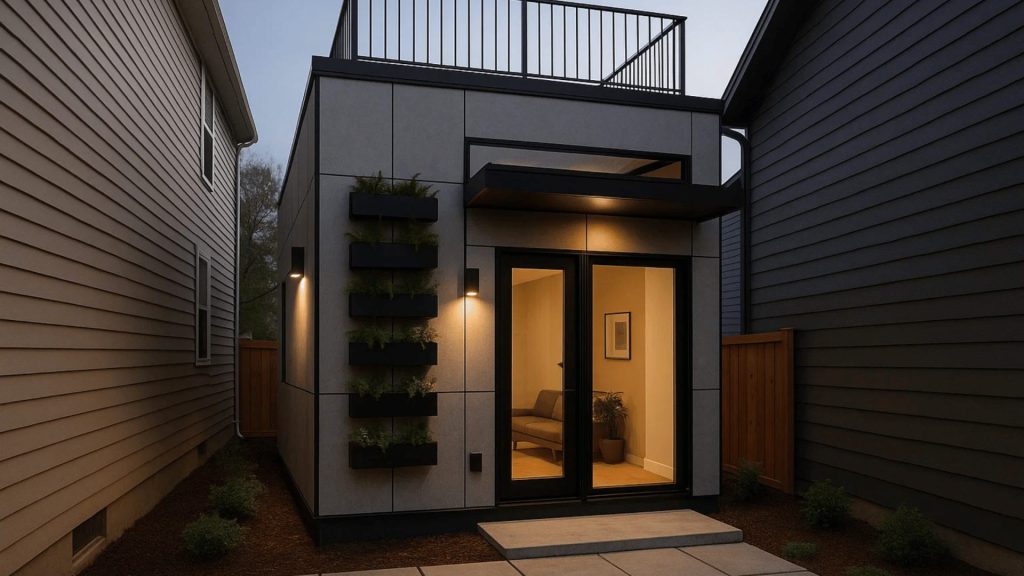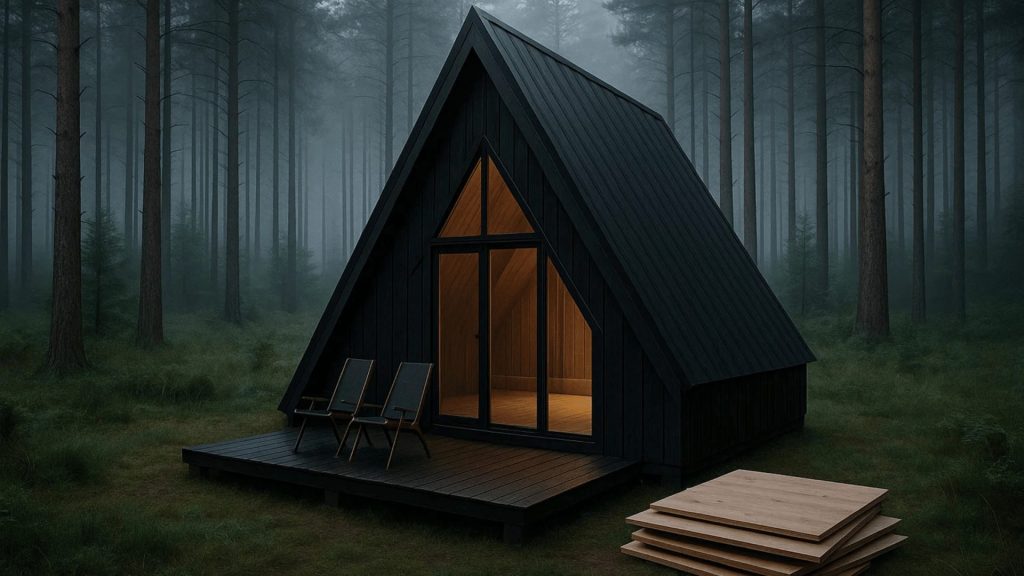The dream of homeownership is changing. As space becomes more precious and the cost of living continues to climb, many Californians are thinking smaller but smarter. Two popular solutions gaining traction are small house kits and tiny homes. Both offer compact living with unique benefits, but they’re not the same.
Small House Kits vs Tiny Homes: Which One Fits Your Needs?
If you’re weighing these two options, or considering an Accessory Dwelling Unit (ADU) as a third path, this guide will help clarify the differences and point you toward the best fit for your property, budget, and lifestyle.
Modern Shift to Compact Living
For homeowners in California, especially in urban and suburban neighborhoods, large traditional homes are often out of reach or unnecessary. Downsizing isn’t just about cost saving it’s about functionality, efficiency, and creating flexible living spaces that suit today’s multi-generational and rental-friendly lifestyles.
That’s where tiny homes, small house kits, and ADUs enter the conversation.
What Is a Small House Kit?
Small house kits are pre-engineered building packages that contain everything you need to construct a small home. They often come with:
- Framing materials (walls, roof, floor system)
- Exterior siding and roofing
- Windows and doors
- Optional interior layout suggestions
These kits are delivered to your property and can be built either by the homeowner (with proper skills and permits) or a licensed contractor.
Key Characteristics of Small House Kits:
- Usually range from 400 to 1,000 square feet
- Built on permanent foundations
- Require standard utility connections
- Meet local building codes when properly permitted
- Allow for full-size kitchens, bathrooms, and bedrooms
Unlike tiny homes, these are not meant to be portable and are usually intended as permanent additions to a property making them more comparable to an ADU than a mobile tiny house.

What Is a Tiny Home?
Tiny homes are typically compact structures under 400 square feet, designed with extreme efficiency in mind. They often include:
- Lofted sleeping areas
- Multi-use furniture (e.g., beds that convert into dining space)
- Compact kitchens and bathrooms
- Built-in storage in walls and floors
Some tiny homes are built on wheels, allowing them to be moved like RVs, while others are fixed on a small foundation.
What Makes a Tiny Home Unique:
- Designed for mobility or minimal permanent footprint
- Often used for temporary or seasonal living
- Focus on minimalism and off-grid living
- Difficult to finance through traditional lenders
- Zoning restrictions apply in many areas of California
Comparing Small House Kits and Tiny Homes
Let’s break down the main differences in a side-by-side view:
1. Size and Space
- Small House Kits: Offer more square footage and traditional layouts
- Tiny Homes: Extremely compact, efficient, sometimes less than 200 sq ft
2. Portability
- Small House Kits: Fixed structures only
- Tiny Homes: Can be mobile or stationary
3. Build Process
- Small House Kits: Delivered and assembled on-site
- Tiny Homes: Built in factories or DIY by owner, sometimes pre-assembled
4. Legal Requirements
- Small House Kits: Must comply with building codes and zoning
- Tiny Homes: Often face challenges due to size and mobility
5. Cost Considerations
- Small House Kits: Typically higher upfront cost, but easier to finance
- Tiny Homes: Lower material cost, but limited resale value and financing hurdles

Benefits of Choosing a Small House Kit
Small house kits serve as a flexible solution for homeowners who want more living space without committing to a full-scale home. These kits make sense in many situations:
- ADU Potential: Can be designed to meet California ADU regulations
- More Liveable Space: Easier to accommodate full-size appliances and comfortable furniture
- Permanent Value Addition: Built on a foundation and recognized as part of the property
- Better Financing Options: Qualify for home improvement or construction loans
Why Some People Prefer Tiny Homes
Despite their size, tiny homes hold appeal for minimalists, adventurers, and those with limited property space.
- Lower Utility Bills: Smaller size means reduced heating, cooling, and water use
- Mobility: Great for those who want the freedom to move
- Minimalist Lifestyle: Encourages decluttering and living simply
- DIY Freedom: Many tiny home enthusiasts enjoy designing and building their own space
Where ADUs Come In: A Strong Alternative in California
Both small house kits and tiny homes have their appeal, but for many Californians, a professionally built ADU often provides a better long-term solution.
Why ADUs Outshine Both in Many Cases:
- Fully permitted and legal under California’s expanding ADU laws
- Increase property value and can be rented out legally for passive income
- Easier to insure and finance
- Can be tailored to match the main home’s look and feel

Use Case Examples: Which Option Fits Your Goal?
| Goal | Best Option |
| Build rental income property | Small House Kit or ADU |
| Travel or move frequently | Tiny Home |
| Create in-law suite on property | ADU or Small House Kit |
| Add value to primary residence | ADU |
| Live off-grid in remote areas | Tiny Home |
Factors to Consider Before Deciding
Here are some important points to help make the right choice:
- Zoning and Local Regulations: Check your city’s code before choosing a mobile or fixed structure
- Available Lot Space: Tiny homes may work on smaller lots where full builds are restricted
- Budget: Consider not only upfront costs but also long-term maintenance and utility expenses
- Lifestyle Needs: Think about who will be living there and for how long
- Future Plans: A structure on a foundation typically offers better long-term property value
The Nestadu Difference
At Nestadu, we specialize in building beautiful, legal, and high-performing ADUs across California. Whether you’re deciding between a small house kit or a more tailored solution, our team walks you through the full process from design and permitting to construction and completion.
We believe in clear communication, reliable craftsmanship, and creating small living spaces that actually feel like home. With Nestadu, you’re not guessing your way through a project. You’re working with experts who know how to navigate the challenges of compact construction in California’s diverse neighborhoods.

Final Thoughts
While tiny homes offer mobility and simplicity, and small house kits provide a customizable structure, neither is as fully suited to long-term California living as an ADU. For homeowners looking for added living space, rental income, or multi-generational solutions, ADUs offer a smart path forward especially when built with the right team.
Frequently Asked Questions
Q: 1 Can a small house kit be considered an ADU in California?
A. Yes, if built on a foundation and permitted correctly, it can qualify as an ADU.
Q: 2 Are tiny homes legal everywhere in California?
A. Not always. Local zoning ordinances vary, and many areas restrict mobile structures or require foundation-built dwellings.
Q: 3 Which is cheaper: a tiny home or a small house kit?
A. Tiny homes usually cost less upfront but may have hidden costs due to zoning, off-grid features, or limited resale appeal.
Q: 4 Is an ADU better for long-term investment?
A. Absolutely. ADUs increase property value, can be rented out legally, and have better financing and resale options.




